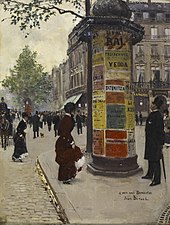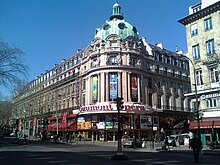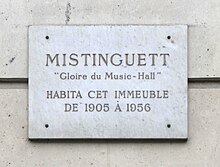2023年3月27日 星期一
Rue Royale, Paris 的Ladurée品賞其招牌的法蘭西多士
2023年3月20日 星期一
Boulevard of Capucines 嘉布遣大道, 巴黎
嘉布遣大道[編輯]
 20世紀初的嘉布遣大道 | |
嘉布遣大道在巴黎的位置 | |
| 道路長度 | 440公尺(1,440英尺) |
|---|---|
| 道路寬度 | 35.40公尺(116.1英尺) |
| 地點 | 法國巴黎 |
| 區 | 第2區、第9區 (第2區,第9區) |
| 起點 | rue Louis-le-Grand, 紹塞當坦路(rue de la Chaussée-d'Antin) |
| 終點 | 嘉布遣路、rue de Caumartin |
| 建造 | |
| 創始日期 | 1685年 |
嘉布遣大道(Boulevard des Capucines)是巴黎一連串的四條東西向大道之一,另外三條是馬德萊娜大道、義大利大道和蒙馬特大道。
嘉布遣大道最初名為「城根街」(Rue Basse-du-Rempart),表明這條街最初與巴黎城牆平行。後來拆除城牆時,街道得以拓寬,成為林蔭大道。
著名地點[編輯]
- 1號:那不勒斯咖啡廳,以作家,記者,和演員主顧著稱。
- 2號:在紹塞當坦路(Chaussée-d'Antin)路口,過去是蒙莫朗西府(hôtel de Montmorency)、雜耍劇場(Théâtre du Vaudeville,1869年),1927年改為派拉蒙電影院。大廳是十八世紀酒店的「大沙龍」。立面的穹頂被保存了下來。
- 5號:皮埃爾-路易皮爾遜的攝影工作室,後來歸屬伽斯底里奧內伯爵夫人的攝影師邁爾兄弟。
- 7號:1825年的Georama:有可能在直徑14米的球體內看到「整個地球」。
- 8號:雅克·奧芬巴赫從1876年到1880年去世生活這裡。
- 12號:大酒店(Grand Hotel),興建在昔日的沼澤花園上。
- 14號:斯克里布酒店(Hotel Scribe),從前這裡是「大咖啡館」(Grand Café),1895年12月28日,盧米埃兄弟在這裡第一次公開放映電影。威廉·倫琴也是在這裡進行了X射線實驗。
- 16到22號:昔日維克多·雨果創辦的《事件報》(L'Évènement)報館。
- 24號:米斯坦蓋(Mistinguett)從1905年到1956年居住在這裡。
- 25號:哥納克-珍博物館(Musée Cognacq-Jay)原址,開設於1931年。
- 27號:從前曾是莎瑪麗丹百貨公司(La Samaritaine,意為「撒瑪利亞婦人」),新藝術運動風格。
- 28號:1889年,這裡是稱為「俄國山」(montagnes russes)的過山車。1893年代之以著名的奧林匹亞音樂廳(約瑟Oller建立於1888年),1952年由布魯諾 Coquatrix贖回。
- 35號:納達(Nadar)住所。1874年4月,一個年輕的畫家群體,包括雷諾瓦、馬奈、畢沙羅和莫奈,在此舉辦第一次畫展。莫奈的畫作《印象·日出》使他們得到印象派的名稱。 莫奈的畫作《嘉布遣大道》現在收藏在莫斯科的普希金博物館或堪薩斯城的納爾遜藝術博物館。
- 37到43號:從1820年到1853年是外交部所在地。1848年2月23日,14軍團的一個營封鎖了這條大道,以保護弗朗索瓦·基佐。當晚,示威者試圖攻破街壘,士兵開槍打死35人,打傷50人。人們把屍體放進自卸車,呼籲巴黎人響應。這是革命的開始,第二天就結束了路易-菲利普一世的統治。
 Boulevard des Capucines at the start of the 20th century | |
| Length | 440 m (1,440 ft) |
|---|---|
| Width | 35.40 m (116.1 ft) |
| Arrondissement | 2nd, 9th |
| Quarter | Madeleine . Chaussée-d'Antin |
| Coordinates |  48°52′16″N 2°20′01″ECoordinates: 48°52′16″N 2°20′01″ECoordinates:  48°52′16″N 2°20′01″E 48°52′16″N 2°20′01″E |
| From | rue Louis-le-Grand, rue de la Chaussée-d'Antin |
| To | rue des Capucines, rue de Caumartin |
| Construction | |
| Completion | since 1685 |
| Located near the Métro stations: Opéra and Madeleine. |
The Boulevard des Capucines is a boulevard in Paris. It is one of the 'Grands Boulevards' in Paris, a chain of boulevards built through the former course of the Wall of Charles V and the Louis XIII Wall, which were destroyed on the orders of Louis XIV.
The name comes from a beautiful convent of Capuchin nuns whose garden was on the south side of the boulevard prior to the French Revolution.
The former name, Rue Basse-du-Rempart ("bottom-of-the-wall street" in French), suggests that, in the beginning, the street paralleled the city wall of Paris. Then, when the wall was destroyed, the street was widened and became a boulevard.
Notable places[edit]
At No. 1 stood the Neapolitan Café, famous for the writers, journalists, and actors who were its patrons, such as Catulle Mendès, Jean Moréas, Armand Silvestre, and Laurent Tailhade.
No. 2, at the junction with the rue de la Chaussée-d'Antin, was the site of the former Hotel de Montmorency, then Théâtre du Vaudeville 1869, later Paramount Opéra movies in 1927 and Gaumont Opéra since 2007. The main hall was the 'grand salon' of the Hotel in the 18th century. The rotunda on the facade has been kept.
No. 5 was the location of the photographic studio of Pierre-Louis Pierson (later associated with the Mayer brothers), who was the photographic collaborator of Virginia Oldoini, Countess di Castiglione.
At No. 7, the Georama was erected in 1825: it was possible to see "the whole earth" inside a sphere 14 meters in diameter.
At No. 8, Jacques Offenbach lived from 1876 and died in 1880.
At No. 12, the Grand Hotel was built on a former swamp-garden.
No. 14 was the site of the Hotel Scribe and the location of the former Grand Café where the first public showing of movies by Auguste and Louis Lumière took place in the Salon Indien on 28 December 1895. Here, too, X-ray light experiments were carried out by Dr. Wilhelm Röntgen.
From No. 16 to No. 22 stood the buildings of the former newspaper L'Évènement, founded by Victor Hugo.
At No. 24, Mistinguett lived from 1905 to 1956.
No. 25 was the former location of the Musée Cognacq-Jay set up in 1931.
At No. 27 stood the former store, the Samaritaine de Luxe, built by Frantz Jourdain, a specialist in Art Nouveau.

No. 28 was the location of a roller coaster called montagnes russes (Russian mountains) in 1889. It was replaced in 1893 by the Olympia theater, a famous music hall founded in 1888 by Joseph Oller and taken over in 1952 by Bruno Coquatrix.
No. 35 was a house where Nadar lived. In April 1874, a group of young painters, including Renoir, Édouard Manet, Pissarro, and Claude Monet, opened the first exhibition of their paintings. The painting by Claude Monet, Impression, Sunrise, gave the exhibitors the name of Impressionists. Another of Claude Monet's paintings, entitled Boulevard des Capucines, is now visible in the Pushkin Museum in Moscow or the Nelson-Atkins Museum of Art in Kansas City, Missouri.
From No. 37 to No. 43 was the former location of the Ministry of Foreign Affairs from 1820 to 1853. On 23 February 1848, a battalion of the 14th regiment blocked the boulevard to protect François Guizot. In the evening, a crowd of demonstrators tried to break down the barricade. The soldiers fired, killing 35 people and wounding 50. The demonstrators put the corpses in a dumper and called the people of Paris to arms. It was the beginning of the revolution which ended the reign of Louis-Philippe the next day.





